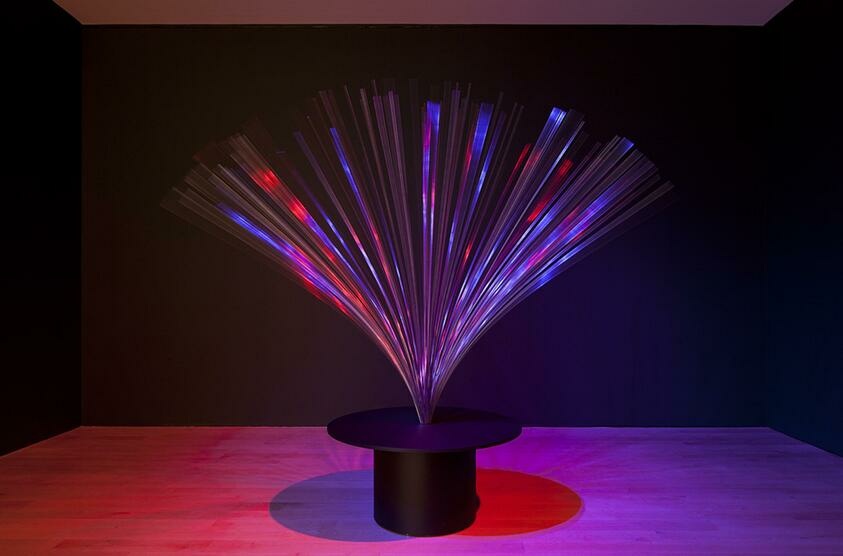Enlarge

Len Lye, originally born in New Zealand, has worked on different media platforms, from kinetic art to experimental filmmaking (mostly by painting on the celluloid directly, without using a camera). But in his early career, he “[at] the age of twenty‐one, he began a life of exile, arriving in Sydney in 1923 to discover a bohemian world of artists, writers, and musicians. Using that Pacific port city as a base, he made his own field trips home to New Zealand and then traveled onto the Cook Islands, Tonga, Fiji, and Samoa, before returning to Sydney in 1925.” (Ann). His exile experiences brought him the passion of blending indigenous cultures of the pacific islanders with surrealistic kinetic visuals. While Stephen Ann called him “oceanic primitivism” while analyzing his early work “Tusalava” that revealed pacific islander culture, he himself claimed to be a figure of motion and kinetic movement (Jones).
What made Len Lye unique among all other audiovisual performance pioneers is his passion for the natural humanistic embodiment of performance, while others tend to converge on this specific point where they all tried to be contra-humanistic and industrialization appeal. In his work “Free Radicals” in 1958, he kept his methods of directly painting on the film to make what could be called “animation”, in black and white. Accompanied by an African tribal music group, the scattered lines Lye drew on the film started twisting in the way of dancing to the rhythm. The groove of the beat hits the rhythm generated by the simple drawing lines. For some parts, the lines even convey a sense of body gestures that have a swing-back-and-forth move to it, giving the lines vivid energy. If one had seen any kind of group dancing performances at this kind of music, they will see the obvious connection that Lye is trying to convey with his animations on the celluloid: group movements with a groove. In the latter periods of the film, several lines entwined together, as if they are performing a kind of ritual ceremony in a specific position. This is a subtle climax with actually very minimal interaction.
Enlarge

Since “Free Radicals” is a made on monochrome film, the usual synesthesia of melody lines (tones) to color patterns is not the case here. The real synesthesia connection is between human body movements and rhythm in the groovy music. In other words, what human body movements mean in this context is the feeling of the intention to dance to the music accordingly, as the body itself is not dancing, while the mind is dancing along with the music. Lye captured this human activity and presented in a minimalist way that avoids visual interference with the natural synesthesia of the mind, while concreted the motion. The point that Lye uses minimal elements to let the audience feel the motion is coherent in his other works, despite its medium. In his kinetic installation work “Fountain” 1963, he connects hundreds of rods to a base, powered by a motor, the rods start to dance freely as if autonomously. With the natural sounds that are made by blending the rods, it is a live generated audiovisual performance.
Enlarge

Works Cited
Stephen, Ann. “The Oceanic Primitivism of Len Lye’s Animation Tusalava (1929).” Art History, vol. 40, no. 3, June 2017, pp. 612–633. EBSCOhost, doi:10.1111/1467-8365.12276.
Jones, Stephen. “Len Lye: Figure of Motion.” ArtAsiaPacific, no. 100, Sept. 2016, pp. 110–119. EBSCOhost, search.ebscohost.com/login.aspx?direct=true&db=edsihs&AN=edsihs.287542456682139&site=eds-live.
You must be logged in to post a comment.